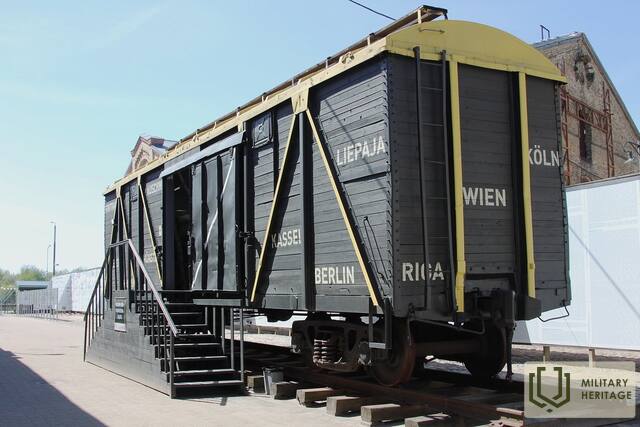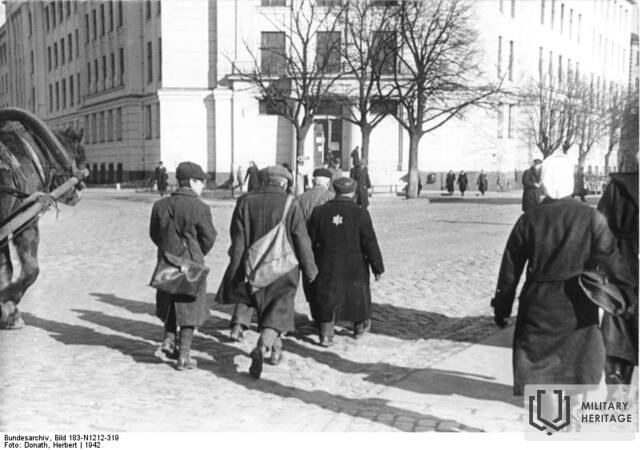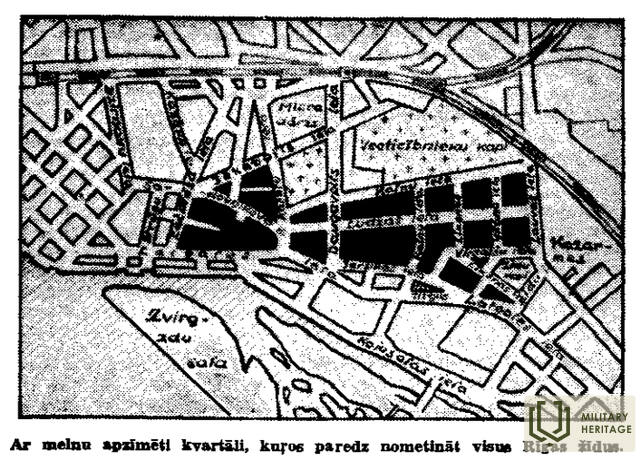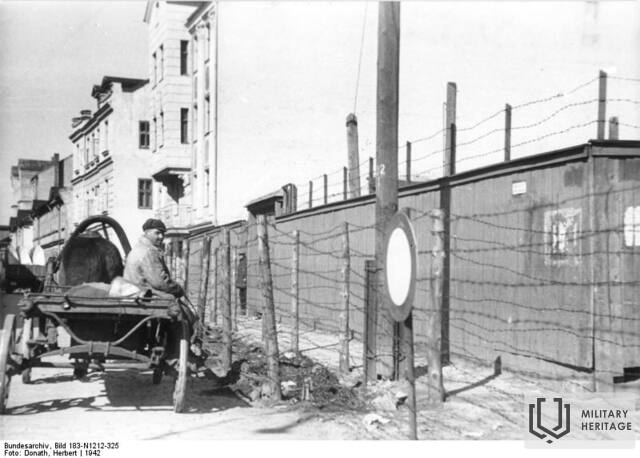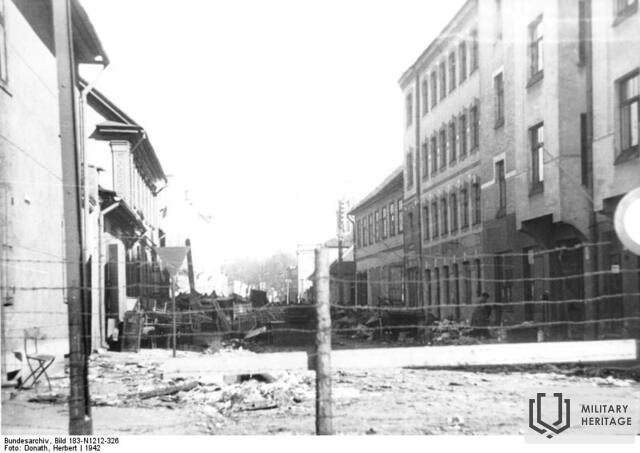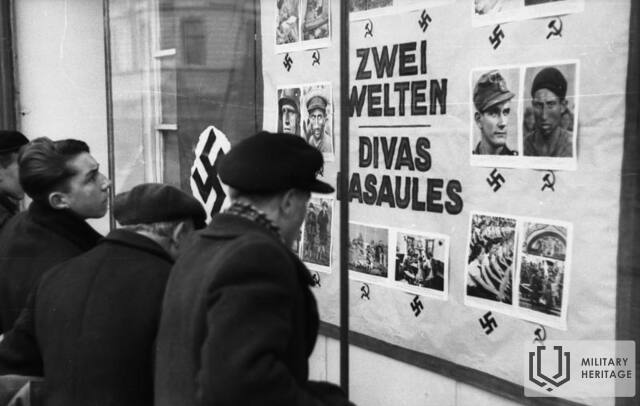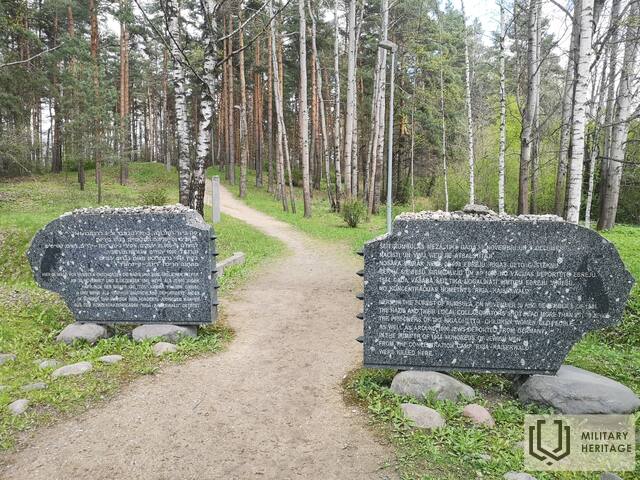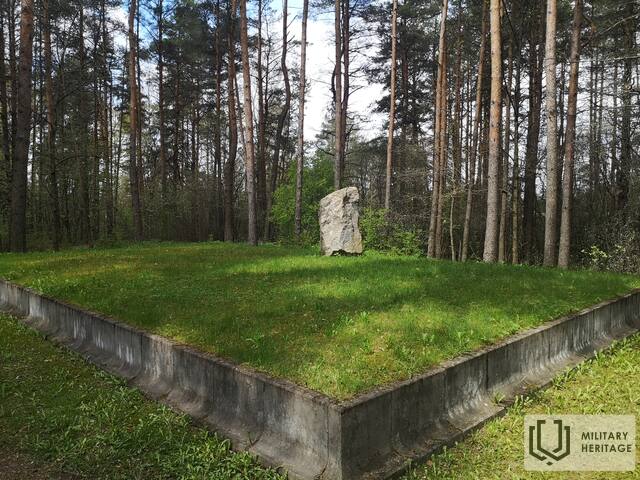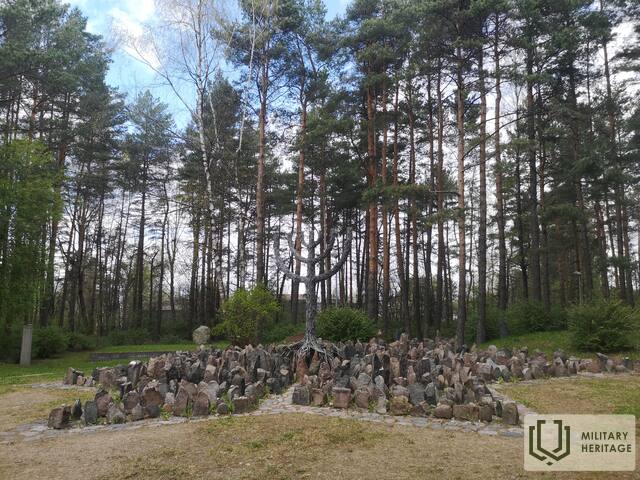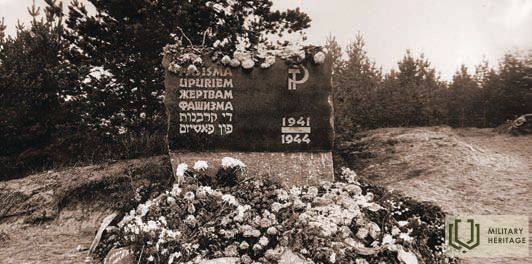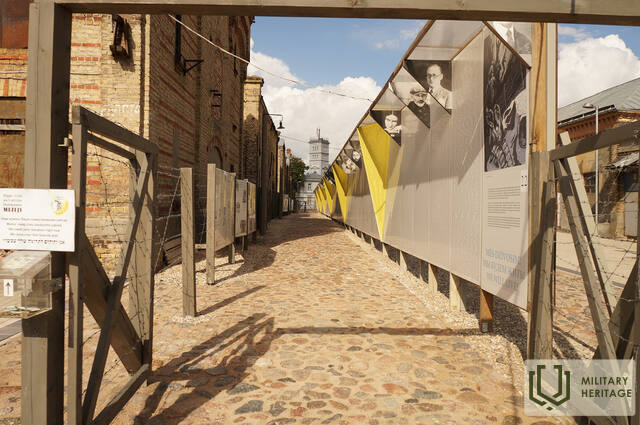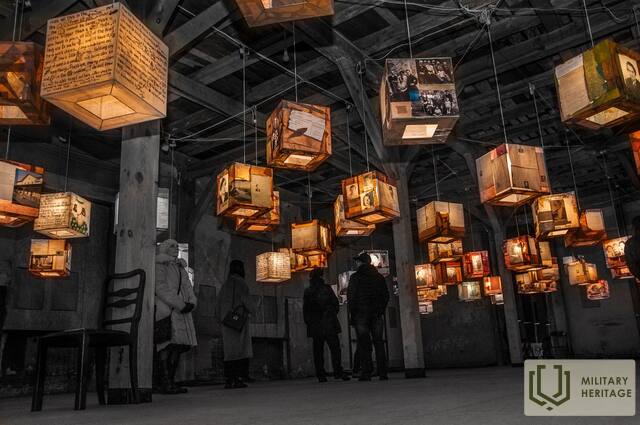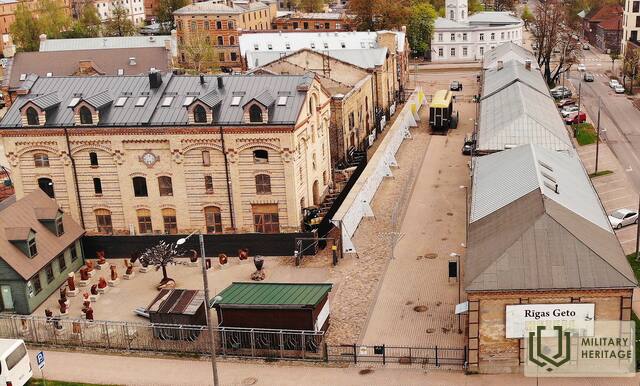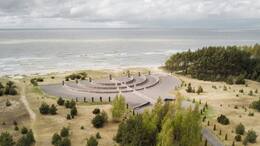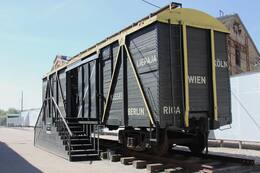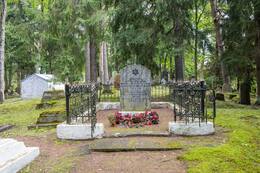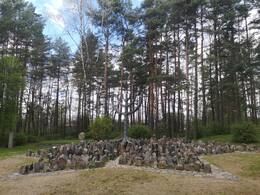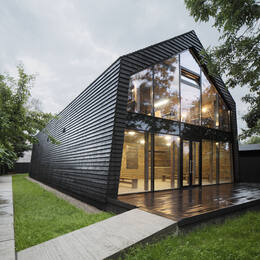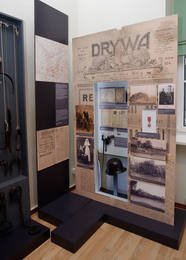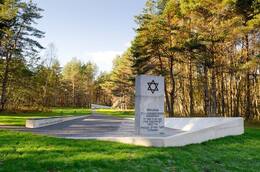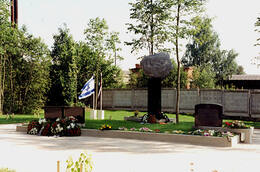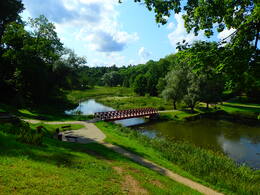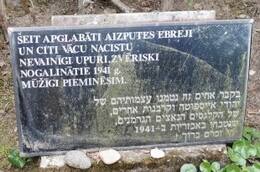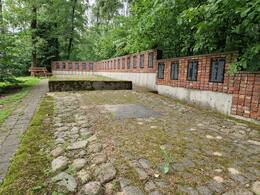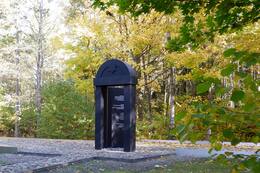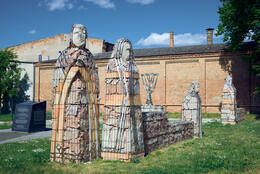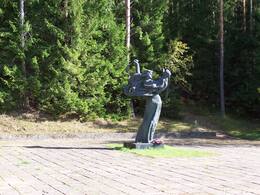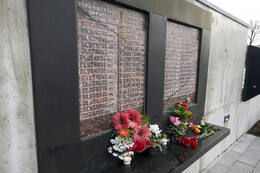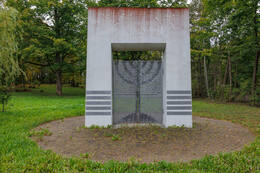Holokaustas II WW2
Der Holocaust (griechische Holos - alle, keine Überreste; in Ätzmitteln verbrannt) - die Massenvernichtung von Juden in Nazi-Deutschland und seinen besetzten Gebieten während des Zweiten Weltkriegs. Der Prozess der Massenvernichtung der Juden begann mit der polnischen Besetzung. Mit dem deutschen Überfall auf die Sowjetunion am 22. Juni 1941 begann die aktive Phase des Holocaust. Die von den Nazis geheim gehaltene sogenannte „Endlösung der Judenfrage“ sollte alle in der UdSSR lebenden Juden töten. In der zweiten Hälfte der 1930er Jahre lebten 93.479 Juden in Lettland (1935). Auch die meisten deutschen, österreichischen, ungarischen und tschechoslowakischen Juden, die während des Krieges hierher deportiert wurden, wurden in Lettland getötet. Der Völkermord richtete sich auch gegen Roma und Geisteskranke in Lettland. Der Holocaust ist das größte Massenverbrechen gegen die Zivilbevölkerung in der Geschichte Lettlands – etwa 73.000 lettische Juden und 16.000 ausländische Juden kamen während der Nazi-Besatzung ums Leben.
Die Umsetzung des Holocaust im deutsch besetzten Lettland wurde zunächst von der deutschen Sicherheitspolizei und der SD-Sondereinheit Einsatzgruppe A, der größten der vier solchen Einzac-Gruppen, durchgeführt. Es wurde von SS-Brigadegeneral und Polizeimajor Walter Stahlecker geführt. Zunächst wurden verschiedene Beschränkungen und Verbote eingeführt, gefolgt von der Registrierung von Juden, die verpflichtet waren, das Symbol des Judentums, den sechszackigen Davidstern, zu tragen. Die Juden wurden von ihrem Eigentum beschlagnahmt, gefolgt von ihrer Isolation und schließlich der Ermordung. Die ersten Morde fanden am 23. Juni 1941 in Grobiņa statt. Die deutschen Militär- und Zivilbehörden mussten ihre Macht aufbauen und die lokale Bevölkerung in die Morde einbeziehen. Sie fanden in allen Siedlungen mit einer kleinen jüdischen Bevölkerung statt. Die Haupttäter der Morde waren speziell gebildete SD-Einheiten unter der Führung von Viktors Arājs und Mārtiņš Vagulāns.
Judaskultgebäude - Synagogen - wurden niedergebrannt. die zweite Hälfte der Chorsynagoge in der Gogoļa-Straße. Am 23. August wurde in den Vororten von Moskau ein Ghetto errichtet, in dem 29.602 Menschen geheilt wurden. 14.000 Ghettos wurden im Ghetto Daugavpils und mehrere Tausend im Ghetto Liepaja untergebracht. Am 30. November und 8. Dezember 1941 wurden unter seiner Führung in Rumbula etwa 25.000 Juden aus Lettland und 1.000 aus Deutschland ermordet. Rund 6.000 Juden mussten nach dem Massaker von Rumbula leben. 1944 wurden die Überlebenden in Lager in Deutschland deportiert. Die deutschen NS-Besatzungsbehörden führten auch Völkermord an Angehörigen der lettischen Roma (Roma) und psychisch Kranken durch. Etwa 2.000 Roma wurden in mehreren lettischen Städten, in psychiatrischen Krankenhäusern in Riga, Daugavpils, Liepaja, Strenči usw. getötet – etwa 2.327 Menschen.
Daugiau informacijos šaltinių
http://okupacijasmuzejs.lv/lv/aktualitates/4-julijs--ebreju-tautas-genocida-upuru-pieminas-diena-379/
Susijusi laiko juosta
Susijusios vietos
Memorial to the victims of holocaust in Liepāja
The largest memorial to Holocaust victims in Latvia is located in Liepāja, in the Šķēde dunes. The memorial is dedicated to the memory of more than 3,000 Liepāja Jews killed during World War II. It is in the form of the Israeli national symbol, a seven-branched candelabra known as the menorah. The contours of the memorial, which are clearly visible from a bird’s eye view, are made of split boulders and granite blocks. The ‘lights’ of the menorah are made of granite pillars with inscriptions of verses from the Lamentations of Jeremiah in Hebrew, English, Latvian and Russian.
Riga Ghetto and Latvian Holocaust Museum
The Riga Ghetto and the Latvian Holocaust Museum is located in Riga close to the Riga Central Market and the Riga Central Station. The museum was opened in 2010 on the site where the city's warehouses once were. It is located in the historical part of the city, next to the border of the former Jewish ghetto. The territory of the ghetto is unique, because in terms of architecture it has not changed since World War II. It is a memorial dedicated to the tragedy suffered by the Jewish people. The German policy regarding the Jewish population in Latvia until the end of 1939 was for the German diplomats and politicians to try and pressure the Latvian government to take action against the Jews by restricting their freedom. After the emigration of the Baltic Germans in 1939, the German embassy no longer had as good an access to information on the mood of the population and the events happening in Latvia as before. When the Red Army occupied Latvia, they manipulated the society to gain some support of the Jewish population for the new occupying power. However, after the regime started a crackdown on the society as a whole, the support fell rapidly. As a result of all this, a deep divide had formed between the people. And later on, the next regime – Germany – tried to exploit it. They hoped that the local population would harass and attack the Jews, but that did not happen. So, Germany adjusted their approach and devised a new plan to initially establish a Jewish ghetto and later destroy its inhabitants.
Varaklani Jewish Cemetery - a memorial to the victims of German-fascist terror
Varakļāni Jewish Cemetery, at the end of Kapsētas Street.
There are two monuments erected in the Varakļāni Jewish cemetery after the war by surviving relatives and relatives.
One of them is located near the cemetery fence, where the mass extermination of Jews took place. The inscription on it in Russian and Yiddish reads: "We will mourn forever with our parents, brothers and sisters who died at the hands of the fascists in 1941." The second monument is inside the cemetery; In the place where the killed Jews were later reburied, there is also an inscription in Yiddish and Russian: "Eternal memory of the victims of the German-fascist terror - the Jews of Varakļāni, brutally killed on August 4, 1941".
Nazi German troops entered Varaklani in 1941. In early July, and from the very first days, the siege and isolated killings of Jews began. A conditional ghetto was established near the Jewish cemetery, to which all Jews had to move. On August 4, a German SD unit (the "Arāja team") shot virtually all Jews in Varakļāni (about 540 people) with the help of local self-defense forces on the territory of the Jewish cemetery.
Every year on the first Sunday of August, a memorial event dedicated to the Jews killed in Varakļāni takes place in the Varakļāni Jewish Cemetery.
Jewish Memorial at Rumbula
Located in Rumbula, near Moskava Street.
Rumbula is one of the largest sites of mass extermination of Jews in Europe. During two actions - 1941. On November 30 and December 8, which were realized based on the Nazi leadership's decision to completely exterminate the Jews imprisoned in the Riga ghetto, more than 25,000 people were shot in the Rumbula forest, including approximately 1,000 Jews deported from Germany. 1944 Several hundred Jewish men from the Kaiserwald concentration camp were also killed in Rumbula.
The first attempts to perpetuate the memory of the Jews killed in Rumbula date back to the end of the 60s. Despite the restrictions of the Soviet government, as a result of the initiative of some Jews in 1963. a wooden commemorative plaque with an inscription in Yiddish was attached to one of Rumbula's pine trees, while a large poster of the artist Josif Kuzkovskis "The Jew" was installed near the Rumbula railway (near the Riga-Moscow line). The poster showed the image of a man rising from the grave with a clenched fist, symbolizing a protest against what had been done. Both the commemorative plaque and the poster already in 1964. were harvested, but the Jews managed to obtain permission to erect a memorial stone in Rumbula with the inscription "Victims of Fascism" not only in Latvian and Russian, but also in Yiddish.
in 2002 On November 29, the memorial ensemble was opened in Rumbula according to the project of architect Sergejs Riž. Its establishment was financially supported by the institutions of Latvia, Israel, the USA and Germany, as well as private individuals.
On the side of the highway, by the road that leads to the memorial, a metal structure symbolizing the forces of Nazism has been installed as a sign. Nearby is a stone with the explanation that thousands of Jews were chased to death along this road. At the entrance to the memorial itself, several stone plaques with inscriptions in Latvian, English, German and Hebrew introduce the events of the Rumbula tragedy and the history of the establishment of the memorial. In the central part of the memorial, above the square, which is made in the shape of the Star of David, rises a seven-branched candlestick - a menorah, surrounded by stones with engraved names of the Jews killed in Rumbula. The names of the streets of the former Riga ghetto are engraved in individual stones with which the square is paved. There are several mass graves on the territory of the memorial, the places of which are marked with rectangular concrete borders.
Žanis Lipke Memorial
The Žanis Lipke memorial is located in Ķīpsala, Riga. The Žanis Lipke Museum is probably one of the most hidden museums in Riga. The obscure location of the memorial is not a coincidence and it has a symbolic meaning. It has been set up in the location of a former underground hideout that was created to save people during the German occupation of World War II. Here Žanis Lipke and his family rescued 55 Jews. Nowadays a memorial has been built next to the Žanis Lipke family house. The memorial ‘Black Shed’ is a symbolic building where shelter was provided and received. The design of the building has been taken from the historical tarred huts of Ķīpsala fishermen and sailors. These huts were built using materials from barges; hence they had a very distinct colour and tar smell. But not only the story of this historic place is unique. The way the museum communicates its message is also quite notable. The overall design has similarities with the Noah’s Ark described in the Bible, and it also resembles a boat that has been pulled ashore and overturned – a boat that has fulfilled its task. The concept of this memorial draws from the historic accuracy of this place and story and the testimonies associated with it. It is a story of a desire for freedom, unbelievable escape and trust. On your way to the museum, you’ll also be able to see the historic buildings of Pārdaugava.
Preiļi Museum of History and Applied Art exhibition "Museum stories for Latvia"
It is located in the premises of the Preiļi Cultural Center.
Preiļi Museum of History and Applied Art (PVLMM) exhibition "Museum stories for Latvia" about the First World War, the War of Independence and the Second World War can be viewed.
The "Story of Drywys" section of the exhibition "Museum Stories for Latvia" (opened in 2018) of the Museum of Preiļi History and Applied Arts is dedicated to the First World War, the War of Independence and the liberation of Latgale, as well as to the knights of the Lāčplešana War Order. The exhibition section "The story of the flag" tells about the difficult events of the Second World War period, during which the people of Preila were affected by deportations, the Holocaust, involvement in the military units of the warring parties, and after the war - in the ranks of national partisans. The "Righteous Among the Nations" medal awarded to Vladislav Vuškānas, the savior of the Jews from Preiliat, can also be viewed.
Upon prior application, a tour is available in Russian and English.
Klooga concentration camp and Holocaust memorial
This memorial to the victims of the Holocaust is situated not far from the small borough of Klooga.
The first monument was erected here in 1951, but it essentially praised the Soviet ideology and did little to commemorate the victims of the Holocaust. In 1994, the plaques on the monument were replaced with new ones at the request of the Jewish community in Estonia so as to do justice to the victims' ethnic roots. On the 50th anniversary of the mass murder perpetrated in Klooga, a monument to the Jews killed in Estonia from 1941-1944 was unveiled 100 metres from the first monument. In 2005, a third monument was unveiled commemorating the Jews who died or were killed in the concentration camp in Klooga.
The memorial was renovated in 2013 to tie the three monuments together, with the Estonian History Museum opening an outdoor exhibition here entitled ‘Klooga camp and the Holocaust’.
Klooga concentration camp was established by the German regime in September 1943. It was a forced-labour sub-camp of the Vaivara concentration camp complex in Estonia. On 19 September 1944, one of the largest mass murders in German-occupied Estonia was committed: all of the Jews at the camp (around 2000 in total) were killed as the Red Army approached.
Preilius Holocaust Memorial
It is located in the Preiļu Jewish cemetery on Cēsu street.
The architect of the memorial is Sergejs Rizh. Opened on August 8, 2004. The memorial was built on the initiative and personal funds of Dāvid Zilbermanis (USA), a former resident of Preiļi, engineer and public worker. In 2015, another monument was added to the memorial - an arch installed at the entrance to the cemetery in the form of a symbolic gate.
The memorial is located on the edge of the Preiļi Jewish cemetery, next to the place where around 800 Jews from Preiļi and the surrounding area were killed in the summer of 1941 after the entry of Nazi German troops with the involvement of local collaborators. The diary of Sheina Gram (1926-1941), a Jewish girl from Preiļi, which she started writing on June 22 - the day the war between the USSR and Germany started - until August 8, is a testimony of the events of this time. Sheina, together with her family and other surviving Jews of Preila, was killed next to the Jewish cemetery on August 9. Thanks to the help of Vladislav Vuškānas (1887-1953) from Preili, 6 Jews from Preili managed to survive the German occupation in hiding. On the stones of the monument are engraved entries from Sheina Gram's diary, as well as words of gratitude to the savior of the Jews, Vladislav Vushkan. An urn with the names of the 750 Jews killed here is buried at the foot of the monument.
SS troops training area "Seelager" and memorial to the prisoners of the concentration camp
At the end of 1943, the Nazi German occupation authorities, planning to expand the SS motorised weapons units, started to build a training ground called "Seelager" (Sea Camp) in the vicinity of Dundaga. The inhabitants of the parishes of Dundaga and Arlava were evacuated to set up the training ground.
In order to build the infrastructure for the camp, several branches of the concentration camp "Kaiserwald" were located in the vicinity of Dundaga, where around 6000 Jews from various European countries (including Latvia) and around 1000 prisoners of war and partisans were imprisoned. Many prisoners died as a result of executions and poor living conditions. Some of the dead were buried in the "Čiekuri" branch camp, which according to some accounts was also the murder site of a group of Jews who were building a narrow-gauge railway towards Mazirbe.
At the beginning of August 1944, after the Soviet invasion of Zemgale, the training ground was liquidated, several thousand untrained SS recruits were sent back to Germany, and the SS motorised brigade Gross was formed from the command, instructors and trained soldiers, named after the commander of the training ground, SS Standard-Sergeant Martin Gross. The Brigade took part in the Battle of Tukums in August 1944, and in the Battles of Iecava and Baldone in September 1944.
After the departure of the SS units, the infrastructure of the training ground was used to accommodate Jews evacuated from Riga and other regions of Latvia, who continued to be used as slave labour.
Misiņkalns Military Heritage Trail
Misiņkalns nature park is located in the town of Aizpute. Misiņkalns is the highest place in the city of Aizpute. Its height reaches 95.4 m. The top offers a scenic view of the city. Misiņkalns nature park was started to be built in the 20th century. at first. The area of the park is currently about 28 ha.
In the territory of the park there are several places and memorials related to the events of the 20th century - the memorial stele of the soldiers who died in the Latvian Freedom Wars - the cavaliers of the Lāčpleš Order, the place of the Holocaust memorial, the place of remembrance of the repressed and the memorial plaque of the fallen red partisans.
In the park, you can get to know the plants and plantations of various rare species, as well as enjoy the untouched nature. Currently, the park is criss-crossed by renovated walking and cycling paths, and there is a motorcycle track on the territory of the park, where Latvian motocross competitions take place.
In order to get to know the cultural and historical heritage of Misiņkalns manor park more fully, we recommend using the services of a guide.
Holocaust reburial site
Nazi troops entered Aizpute in 1941. on June 28. Already at the beginning of July, some Jews were shot in the Dzirkali forest and the city park, while the rest of the Jews of the city and the immediate surroundings were arrested and placed in two city synagogues.
After that, the mass killing of Jews took place during two actions.
Today, a monument with an inscription in Hebrew and Latvian has been installed at the reburial site: "The Jews of Aizpute and other innocent victims of the German Nazis, brutally killed in 1941, are buried here. We will remember forever."
Kaušėnų Holokausto aukų memorialas
Kaušėnų kaime (Plungės r.) žydų žudynių vietoje įrengtas Kaušėnų Holokausto aukų memorialas. Memorialas yra skirtas II-ojo Pasaulinio karo metais sunaikintai Plungės ir aplinkinių kaimų žydų bendruomenei atminti.
Memorialas įkurtas paskutiniojo Plungės žydo Jakovo Bunkos iniciatyva. Pirmasis paminklas iškilo 1952 m. II Pasaulinio karo aukoms, o 1986-1989 m. įkurtas ir memorialas iš ąžuolinių paminklų žuvusiems žydams pagerbti. 2011 m. įrengta Atminties siena, kuri sumūryta iš 1800 nugriautos Plungės sinagogos plytų, kurių kiekviena skirta nužudytajam atminti, o prie sienos pritvirtintos plokštės su žinomomis 1200 (iš 1800) žydų pavardėmis. Greta memorialo sukurta Gelbėtojų alėja, kurioje ant atskirų vardinių stulpelių surašyti asmenys nacių okupacijos metais Plungėje ir jos apylinkėse gelbėję pasmerktuosius žydus.
1941 m. liepos 12-13 d. Kaušėnų kalnelyje buvo nužudyta ir palaidota apie 1800 Plungės krašto žydų, prieš tai 2 savaites laikytų Plungės sinagogoje žiauriomis sąlygomis. Genocido dieną galintys eiti buvo varomi pėsti 5 km į egzekucijos vietą, kiti buvo sunkvežimiais vežami atskiromis grupėmis. Aukoms buvo liepta išsikasti sau duobes po ko buvo sušaudomi. Kita grupė turėjo užkasti nužudytus ir iškasti naują duobę sau.
Memorialas yra įspūdingiausių Europos žydų tautos tragediją atspindinčių memorialų dešimtuke.
Šeduvos žydų holokausto vieta Pakutenių kaime
Pakutenių miške (Radviliškio r.), apie 8 km į pietryčius nuo Šeduvos šalia žvyrkelio yra viena iš 3 Šeduvos žydų holokausto vietų.
Šioje vietoje 1941 m. rugpjūtį buvo nužudyti 27 žydai, įskaitant paskutinį Šeduvos rabiną Mordechajų Dovydą Henkiną. Tuo tarpu kitose dviejose vietose Liaudiškių miške nužudyta dar apie 700 žmonių.
Naciams užėmus Šeduvą 1941 metų birželio 25 dieną, jau liepos pradžioje miestelio žydai prievartos būdu iškeldinti iš savo namų ir išvaryti į gretimą Pavartyčių kaimą, kur buvo įrengtas getas. Rugpjūčio 25-26 dienomis nedidelė dalis jų sušaudyta Pakutenių, likusieji – Liaudiškių miške.
2014-2015 m. Šeduvos žydų memorialinio fondo iniciatyva žudynių vietos buvo sutvarkytos ir pritaikytos lankymui. Pakutenių žydų žudynių vietoje įrengtas skulptoriaus Romo Kvinto paminklas „Šviesos žvaigždės buveinė“.
Šeduvos žydų I ir II holokausto vietos
Šeduvos I ir II holokausto vietos yra Liaudiškių miške (Radviliškio r.), apie 10 km į pietvakarius nuo Šeduvos. Žvyrkelyje pastatyta lankytino objekto nuoroda.
Pirmoji žydų tautybės žmonių palaikų kapavietė užima mišku apsuptą 375 m² dydžio teritoriją, kurios didesnė dalis išgrįsta akmenimis. Šioje vietoje nužudyta ir užkasta apie 400 žmonių. Už maždaug 500 m yra antroji kapavietė. Žydų tautybės žmonių palaikai palaidoti 144 m² dydžio teritorijoje. Aikštelės reljefas lygus, didesnė dalis teritorijos taip pat išgrįsta akmenimis. Šioje vietoje nužudyta ir užkasta apie 300 žmonių.
1941 m. šiose vietose buvo nužudyta visa Šeduvos miestelio žydų bendruomenė – beveik 700 žmonių. Prieš tai jie dar mėnesį praleido Pavartyčių kaime įkurtame gete. Rugpjūčio 25-26 d. geto gyventojai buvo išvežti į Liaudiškių mišką. Prie iškastos duobės buvo atvaromi pasmerktieji, kuriuos vokiečių įsakymu nužudė vietiniai policininkai ir baltaraiščiai tarp nužudytųjų buvo 230 vyrų, 275 moteris ir 159 vaikai.
2014-2015 m. Šeduvos žydų memorialinio fondo iniciatyva žudynių vietos buvo sutvarkytos ir pritaikytos lankymui. Žudynių vietose įrengti 2 skulptoriaus Romo Kvinto paminklai: „Durys“ ir „Spindulys-žvaigždė“.
Memorial "Synagogue Garden"
Located in the center of Bauska, near the Bauska Regional Tourist Information Center, Town Hall Square.
The memorial "Synagogue Garden" was created thanks to the initiative of Bauska Jewish descendants in Israel, the USA and Great Britain, donations, and the support of the Bauska Regional Council, Latvian Jewish congregations and communities.
The memorial was designed by sculptor Ģ. Burvis, who is also the author of the V. Plūdonis monument. The memorial was created in the size of the former Great Synagogue of Bauska, the stone figures symbolize Jews coming out of the church after the service. In the center of the memorial is a symbolic bimah, on which is written: “A dedication to the Jews of Bauska, who lived here for centuries and built this city, and who were killed in 1941 by the Nazis and their local assistants. Honoring the memory of the Jewish people – the descendants of the Jews of Bauska and the people of Bauska. In 1935, almost 800 Jews lived in Bauska. After the Nazi occupation in July 1941, many Jews were arrested, deported, and approximately 700 were shot. The Great Synagogue of Bauska was destroyed during World War II.
Ančupāni Memorial in Memory of the Victims of World War II
Dedicated to the residents of Rēzekne district killed during the Nazi occupation. In the Ančupāni Hills, starting in August 1941, Jews from Rēzekne and surrounding villages, supporters of the communist occupation regime, Red Army soldiers, etc. were shot. Among the killed were also 203 residents of the village of Audriņi, Makašēni parish, who were killed on January 3, 1942.
The memorial was opened on July 27, 1974. Its author is landscape architect Alfons Kišķis (1910–1994). The evergreen fir trees on the right side of the road symbolize the people lined up for execution, the stone wall on the opposite side of the road symbolizes the shooters. In the lower part – in the Valley of Suffering – a path covered with boulders leads past the mass graves of the shot people, ending at a concrete wall with the inscription “They died so that you could live”. Further on, there are stairs to the Square of Life, the author of the central sculpture “Mother Apple Tree” of which is the sculptor Rasa Kalniņa-Grīnberga (1936).
Memorial to the victims of Audriņi village
A memorial plaque at the former Rēzekne prison, opened in 1965. Dedicated to thirty men from the village of Audriņi, Makašēni parish, who were publicly shot at this location on January 4, 1942. The names of the 30 men who were shot are engraved on the plaque.
Shortly before that, it was discovered that escaped Red Army prisoners of war were hiding in the village of Audriņi. In the armed clashes that broke out during their capture, 4 auxiliary police officers were killed. The Nazi occupation authorities, in revenge for what had happened, ordered the killing of all the inhabitants of Audriņi and the burning of the village. The public execution in Rēzekne was part of the revenge campaign.
Holocaust Memorial
In August 2004, a Holocaust Memorial was opened on Cēsu Street in Preiļi. The architect was Sergejs Rižs, and the author and financier of the idea was David Zilbermanis, a local resident living in the United States. The memorial is located in the area between the graves of Jewish citizens and the shooting pits of Jewish residents.
The first Jews arrived in Preiļi at the beginning of the 19th century, when the town of Preiļi began to form. According to the 1935 census, out of 1,662 residents of Preiļi, 847 (51%) were Jews. Most of them were merchants, craftsmen, as well as intelligentsia – doctors and teachers.
When the German Nazi army entered on July 28, 1941, more than 720 Jews from Preiļi and the surrounding area were exterminated on August 9 and 10. After the war, some Jews returned to Preiļi, but the community was never restored.
In 2013 and 2014, students of the German youth association LOT and its leader Klaus Peter Rex carried out clean-up and monument cleaning work at the Jewish citizens' cemetery. A map of the cemetery was drawn up. In 2015, at the initiative of David Zilbermanis, with his funding and donations, a memorial arch was opened for the Jewish community in Preili, at the entrance to the Jewish citizens' cemetery, on the way to the Holocaust Memorial.
In 2018, the Preiļi Memorial Society (chairman Sergejs Rižs) conducted excavation work at the site of the killing of Jews next to the cemetery of Jewish citizens. Three pits were discovered. After conservation, the material evidence can be viewed in the main exhibition of the Preiļi History and Applied Arts Museum at Raina Boulevard 28. Museum specialists offer visitors the educational program “Thinking about the Holocaust means thinking about yourself.” The program begins in the museum exhibition and ends at the Holocaust Victims Memorial. The memorial, together with the cemetery, is used to educate the public as an open-air museum.
Zugehörige Geschichten
Rigaer Ghetto und der Holocaust
Bewusst wurden drei Fragmente der Erinnerungsgeschichten verschiedener Personen gewählt, die es uns erlauben, das Holocaust-Verbrechen aus verschiedenen Blickwinkeln genauer zu betrachten.
Davidstern an der Gedenkstätte des Konzentrationslagers Dundagh
Nach der Wiedererlangung der Unabhängigkeit installierten die Bewohner von Dundaga einen großen hölzernen Davidstern an der Stelle der Ermordung und Umbettung der Juden in der Nähe der Autobahn Mazirbe - Dundaga, und später eröffnete der Rat der jüdischen Gemeinden und Gemeinden Lettlands daneben einen Gedenkstein es.




